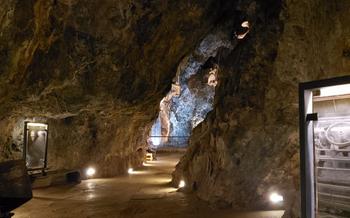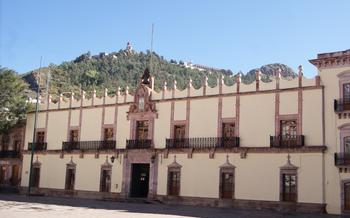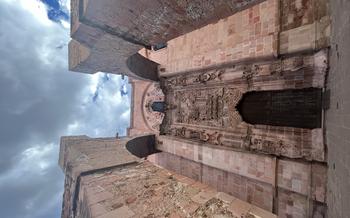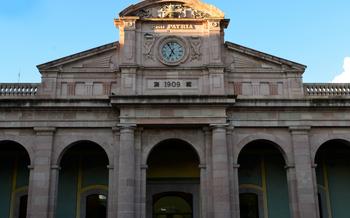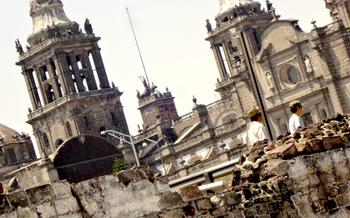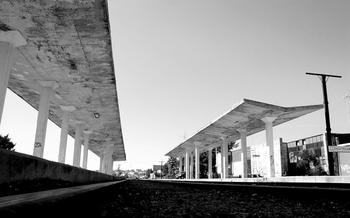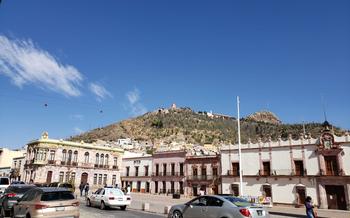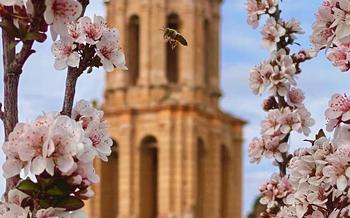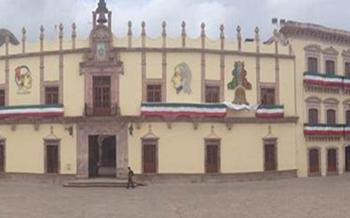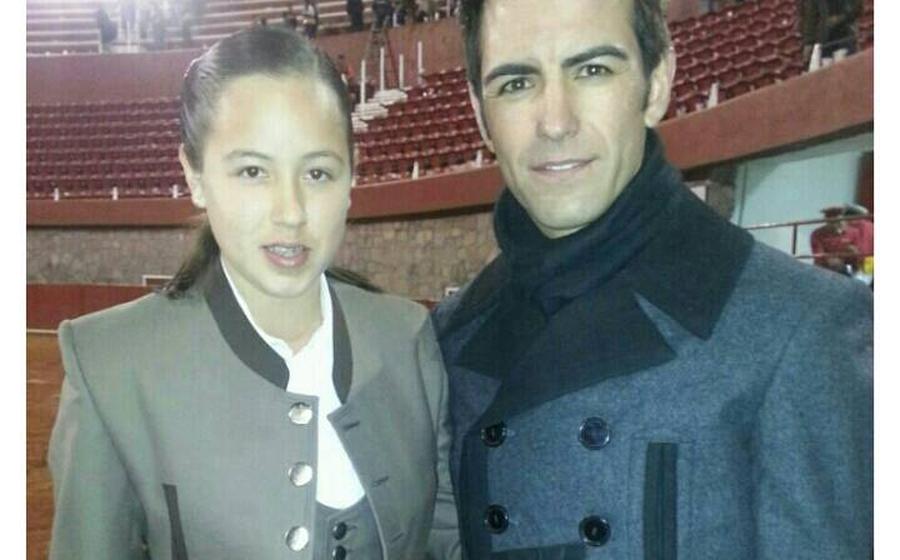
Plaza de Toros Monumental de Zacatecas
- The Majestic Plaza de Toros Monumental de Zacatecas
- A Legacy of Bullfighting in Mexico
- Exploring the Structure of the Plaza de Toros
- Witnessing a Bullfight at the Plaza
- Famous Matadors and Legends of the Ring
- The Cultural Significance of Bullfighting
- Visiting the Bullring Museum
- Around the Plaza de Toros
- The Plaza's Role in Local Festivities
- Booking Tickets and Planning Your Visit
- Capturing the Moment: Photography and Videography
- A Unique Cultural Experience
- Respecting Local Customs and Traditions
- Insider Tip: Beyond the Bullring
The Majestic Plaza de Toros Monumental de Zacatecas
The Plaza de Toros Monumental de Zacatecas stands as a testament to the rich history and cultural significance of bullfighting in Mexico. Constructed in 1866, this magnificent bullring is a masterpiece of 19th-century architecture, blending Moorish, Gothic, and Neoclassical styles in a harmonious and striking manner. Its imposing presence dominates the cityscape, emerging as a symbol of Zacatecas' cultural heritage and a source of pride for its residents.
The origins of bullfighting in Mexico can be traced back to the 16th century, when it was introduced by the Spanish conquistadors. Over time, it evolved into a unique Mexican tradition, deeply rooted in the country's history, identity, and artistic expression. Bullfighting in Mexico is not merely a sport but a cultural phenomenon, entwined with the nation's folklore, music, literature, and visual arts.
The Plaza de Toros Monumental de Zacatecas holds a prominent position in the Mexican bullfighting landscape. It is considered one of the most important bullrings in the country, renowned for its architectural grandeur, exceptional acoustics, and the historic bullfights that have taken place within its hallowed grounds. This iconic landmark embodies the essence of Mexican bullfighting, serving as a stage for some of the most celebrated matadors and legendary bullfights in the sport's history.
A Legacy of Bullfighting in Mexico
Bullfighting, known as "corrida de toros", has a long and storied history in Mexico. Its origins can be traced back to the 16th century when Spanish conquistadors brought the tradition to the New World.
Over time, bullfighting became deeply ingrained in Mexican culture, evolving into a unique spectacle that showcased the bravery, skill, and artistry of matadors, while also representing a symbol of national identity.
While the origins of bullfighting can be traced back to ancient Greece, its modern form was developed in Spain in the 18th century. In the 16th century, Spanish conquistadors brought bullfighting to Mexico, where it quickly became a popular pastime. Bullfighting reached its peak of popularity in Mexico in the 19th and early 20th centuries and was considered a national sport.
Despite its popularity, bullfighting has always been controversial in Mexico. There have been many attempts to ban bullfighting, but it has always been defeated by popular demand. In recent years, there has been a growing movement to end bullfighting, and several states have banned the practice. However, bullfighting is still legal in most parts of Mexico, and it remains a popular attraction for tourists.
Exploring the Structure of the Plaza de Toros
The Plaza de Toros Monumental de Zacatecas boasts an impressive architectural style and design features that set it apart from other bullrings in Mexico. Constructed in a neoclassical style, the exterior facade of the bullring features intricate carvings, decorative arches, and elegant columns. The symmetrical design and harmonious proportions create a sense of grandeur and monumentality.
Inside the bullring, the seating capacity of over 14,000 spectators is arranged in a tiered fashion, providing excellent views of the arena from all angles. The seating areas are divided into different sections, including shaded areas for protection from the sun, and private boxes for VIP guests.
The bullfighting arena itself is spacious and well-maintained, with a carefully leveled sand surface that ensures the safety of the matadors and bulls. The bullring is surrounded by a protective barrier, consisting of a series of wooden panels, which helps to prevent accidents and injuries.
Unique to the Zacatecas bullring is its location within a larger sports complex. The Plaza de Toros is situated next to a soccer stadium, creating a vibrant sports atmosphere in the area. This proximity to other sporting venues adds to the significance of the bullring as a symbol of Zacatecas's cultural heritage and sporting traditions.
Witnessing a Bullfight at the Plaza
Attending a bullfight at the Plaza de Toros Monumental de Zacatecas is an unforgettable experience that immerses visitors in the heart of Mexican culture. Before the fight begins, a series of traditional rituals and ceremonies take place, setting the stage for the spectacle to come. Matadors, dressed in their elaborate costumes, parade into the arena, accompanied by the rhythmic sounds of trumpets and drums. The crowd erupts in cheers and applause as the matadors pay homage to the bull and the spectators.
Once the formalities are complete, the bull is released into the arena. The matador, armed with his cape and sword, begins the intricate dance of bullfighting. With grace and agility, he maneuvers around the bull, studying its movements and anticipating its attacks. The crowd holds its breath as the matador inches closer, teasing and provoking the bull, all the while maintaining a safe distance.
The sequence of events in a bullfight is carefully choreographed, with each pass of the cape and each thrust of the sword having a specific purpose. The matador's goal is to weaken and exhaust the bull while showcasing his own skill and courage. The crowd reacts with a mix of excitement and trepidation, cheering for the matador's daring moves and gasping at the close calls.
Etiquette and customs play an important role in attending a bullfight. Spectators are expected to dress respectfully and to refrain from talking or making noise during the performance. Applause and cheers are reserved for moments of exceptional skill or bravery. By following these customs, visitors can show their appreciation for the tradition and contribute to the overall atmosphere of the event.
Famous Matadors and Legends of the Ring
The Plaza de Toros Monumental de Zacatecas has witnessed some of the most legendary bullfights in Mexican history, featuring renowned matadors who have left an indelible mark on the sport. Among them, Carlos Arruza, known as "El Ciclón Mexicano," stands out as one of the greatest matadors of all time. His daring performances and mastery of the cape captivated audiences, earning him international fame and admiration.
Another Zacatecan bullfighter who gained international recognition was Rafael Rodríguez, nicknamed "El Volcán de Zacatecas." With his exceptional skill and courage, he faced some of the fiercest bulls in the ring, becoming a crowd favorite for his thrilling displays of bravery.
In recent years, Alejandro Martínez Vértiz, known as "El Palomo," has emerged as one of the leading matadors in Mexico. Hailing from a family of bullfighters, he has showcased his exceptional talent and artistry in the ring, winning numerous awards and accolades.
These legendary matadors, along with many others, have contributed to the rich history and tradition of bullfighting in Zacatecas. Their performances have captivated audiences, solidified the city's reputation as a bullfighting stronghold, and cemented their place in the annals of bullfighting history.
The Cultural Significance of Bullfighting
Bullfighting holds a profound cultural significance in Mexico, deeply intertwined with the nation's identity and heritage. It is viewed as a symbol of bravery, skill, and artistry, embodying the Mexican spirit of overcoming adversity. The spectacle of the bullfight, with its intricate rituals, colorful costumes, and moments of high drama, has captivated audiences for centuries, becoming an integral part of Mexican culture.
Bullfighting has inspired numerous works of art, literature, and music, leaving an indelible mark on the country's cultural landscape. Renowned Mexican artists such as Diego Rivera and José Clemente Orozco have depicted bullfighting scenes in their murals, capturing the intensity and emotion of the event. Celebrated Mexican writers like Juan Rulfo and Carlos Fuentes have explored the themes of bullfighting in their literary works, delving into its cultural significance and impact on Mexican society.
However, bullfighting has also been a subject of controversy and debate in recent years. Animal rights activists have raised concerns about the treatment of bulls and the inherent violence of the sport. Protests and demonstrations against bullfighting have become increasingly common, leading to discussions about animal welfare and the ethics of the tradition.
Despite the controversies, bullfighting remains a deeply rooted tradition in many parts of Mexico, with strong support from aficionados who view it as an integral part of their cultural heritage. The Plaza de Toros Monumental de Zacatecas stands as a testament to this enduring legacy, showcasing the artistry and spectacle of bullfighting while also inviting visitors to explore its complex cultural significance.
Visiting the Bullring Museum
The Plaza de Toros Monumental de Zacatecas is home to a fascinating museum that delves into the rich history and traditions of bullfighting in Mexico. This immersive exhibition showcases a diverse collection of artifacts, photographs, and interactive displays that provide visitors with a comprehensive understanding of the sport.
The museum's exhibits take visitors on a journey through the evolution of bullfighting in Zacatecas, from its humble beginnings to its current status as a cultural icon. Visitors can admire the intricate costumes worn by matadors, examine the specialized tools used in bullfights, and learn about the breeding and training of fighting bulls.
Interactive displays and multimedia presentations bring the history of bullfighting to life, allowing visitors to experience the thrill and excitement of the sport firsthand. Guided tours led by knowledgeable experts provide deeper insights into the techniques, rituals, and controversies surrounding bullfighting.
Through the museum's exhibits, visitors gain a deeper appreciation for the cultural significance of bullfighting in Mexico and its impact on the country's art, literature, and music. The museum serves as a valuable resource for anyone interested in exploring the complex and controversial world of bullfighting.
Note: It is important to note that while bullfighting is a controversial topic, the museum presents a balanced and informative perspective, allowing visitors to form their own opinions on the subject.
Around the Plaza de Toros
The Plaza de Toros Monumental de Zacatecas is not just a bullfighting arena; it's a cultural hub that attracts visitors from all over the world.
In the vicinity of the bullring, you'll find a myriad of attractions that will enrich your experience in Zacatecas. Take a leisurely stroll and discover the beauty of the surrounding architecture, with its colonial-era churches, colorful buildings, and charming plazas.
Indulge in the local cuisine at one of the many restaurants and cafes in the area, where you can savor traditional Mexican dishes and sample the region's famous mezcal.
Stroll through the vibrant markets, where you can haggle for souvenirs and handicrafts, from intricate pottery and woven textiles to handcrafted jewelry and leather goods.
Immerse yourself in the city's vibrant cultural scene by attending concerts, theater performances, and art exhibitions held in venues near the bullring.
Whether you're a history buff, an art enthusiast, or simply looking for a fun and authentic Mexican experience, the area surrounding the Plaza de Toros Monumental de Zacatecas has something to offer everyone.
The Plaza's Role in Local Festivities
The Plaza de Toros Monumental de Zacatecas is not just a venue for bullfights; it also plays a significant role in local festivities and cultural events. The bullring is often used for special celebrations, traditional festivals, and religious observances. During these occasions, the plaza transforms into a vibrant hub of activity, showcasing the rich cultural heritage of Zacatecas.
One of the most prominent events held at the bullring is the annual Zacatecas Cultural Festival. This festival is a celebration of the city's history, traditions, and artistic expressions. The bullring hosts various performances, concerts, and exhibitions during the festival, attracting locals and tourists alike.
Bullfights are also an integral part of local holidays and religious observances in Zacatecas. During these special days, the bullring becomes a place of gathering, where the community comes together to celebrate and honor their traditions. The bullfights are often accompanied by traditional music, dance, and other cultural performances, creating a festive atmosphere that is both exciting and immersive.
By integrating bullfighting into the community's cultural fabric, the Plaza de Toros Monumental de Zacatecas plays a vital role in preserving and promoting local traditions. It serves as a platform for cultural expression and a gathering place for the community to celebrate their shared heritage.
Booking Tickets and Planning Your Visit
Attending a bullfight at the Plaza de Toros Monumental de Zacatecas is an unforgettable experience that requires careful planning. Ticket prices vary depending on the seating category and the popularity of the bullfight. It's advisable to purchase tickets in advance, especially for major events, to secure the best seats.
When choosing your seats, consider your budget and preferences. The higher sections offer a panoramic view of the bullring, while the lower sections provide a closer and more immersive experience. Dress appropriately for the occasion, opting for smart casual attire. Remember that bullfights are formal events, and dressing respectfully shows your appreciation for the tradition.
International visitors should be aware of the cultural significance of bullfighting in Mexico. While it may not align with everyone's personal beliefs, it's important to approach the event with an open mind and respect for local customs. Engaging with locals and asking questions can provide valuable insights into the cultural context of bullfighting.
Capturing the Moment: Photography and Videography
Documenting your experience at the Plaza de Toros Monumental de Zacatecas through photography and videography can be a rewarding way to capture the spectacle and share it with others. Here are some guidelines to ensure a successful and respectful documentation:
-
Respect Privacy: Remember that the bullfighting event is a private gathering, and it is essential to respect the privacy of the bullfighters, spectators, and event organizers. Avoid taking intrusive or disrespectful shots that may compromise their privacy or disrupt the event.
-
Silent Shutter: To minimize distractions during the event, consider using a camera with a silent shutter mode, especially during critical moments of the bullfight. This will help you capture the action without disturbing the participants or spectators.
-
Wide-Angle Lens: A wide-angle lens can be particularly useful for capturing the full scope of the bullring, the audience, and the action in the arena. This can help you convey the atmosphere and grandeur of the event.
-
Action Shots: To capture the dynamic movements of the bull and the matador, use a fast shutter speed to freeze the action. This will allow you to capture the intensity and drama of the bullfight.
-
Respectful Sharing: When sharing your photos and videos online, be mindful of respecting the cultural significance of the event. Avoid captions or comments that may be offensive or disrespectful to Mexican culture or the traditions of bullfighting.
A Unique Cultural Experience
Witnessing a bullfight at the Plaza de Toros Monumental de Zacatecas is an experience that transcends mere entertainment. It offers a glimpse into the heart of Mexican culture, where tradition, spectacle, and artistry intertwine. The atmosphere is electric as the crowd erupts in cheers and jeers, their emotions swaying with the ebb and flow of the fight. The matador's grace and agility, the bull's strength and unpredictability, and the interplay between them create a captivating spectacle.
Beyond the spectacle, there is a deep cultural significance to bullfighting in Mexico. It is a tradition that has been passed down through generations, woven into the fabric of Mexican identity. Attending a bullfight is not just about watching a fight; it is about immersing oneself in a cultural ritual, understanding its history, and appreciating its intricate symbolism.
For me, attending a bullfight in Zacatecas was a profound and unforgettable experience. It was more than just a sporting event; it was a cultural journey that left me with a deeper appreciation for the complexities of Mexican society and traditions. The emotions, the spectacle, and the cultural immersion made it a truly unique and awe-inspiring event.
Respecting Local Customs and Traditions
When attending a bullfight in Zacatecas, it is essential to be mindful and respectful of local customs and traditions. Demonstrating cultural sensitivity and awareness will help you enjoy the experience fully and avoid any misunderstandings. Remember that bullfighting is deeply rooted in Mexican culture, and many locals hold it in high regard.
Engaging with locals and asking questions can be a great way to learn more about the tradition and their perspectives. However, be respectful and avoid asking intrusive or offensive questions. Remember that bullfighting can be a controversial topic, so it's best to approach conversations with an open mind and a willingness to listen.
During the bullfight, follow the etiquette and customs of the event. For example, avoid talking loudly or making disruptive noises during the performance. Applaud and cheer when appropriate, but do not boo or jeer at the bullfighters or the bull. Remember that bullfighting is a spectacle, and the participants are risking their lives in the ring.
By demonstrating respect for local customs and traditions, you can contribute to a positive and enjoyable experience for yourself and those around you. Embrace the cultural significance of bullfighting and engage with the locals to gain a deeper understanding of this unique aspect of Mexican heritage.
Insider Tip: Beyond the Bullring
While the Plaza de Toros is a major attraction, Zacatecas offers a wealth of other cultural experiences. Explore the city's historic center, a UNESCO World Heritage Site, with its colonial architecture, charming plazas, and museums. Visit the Gothic-style Zacatecas Cathedral, a stunning example of Mexican Baroque architecture. Immerse yourself in the local culture at the Museo Pedro Coronel, showcasing the works of the renowned Zacatecan artist.
Venture beyond the city to discover the surrounding region's natural beauty. Explore the Sierra de Órganos National Park, with its unique rock formations, or take a scenic drive through the Cumbres de Zacatecas mountain range. Experience the thrill of adventure with outdoor activities like hiking, mountain biking, and rock climbing.
Savor the flavors of Zacatecas' culinary scene, known for its traditional dishes like enchiladas zacatecanas and asado de boda. Indulge in local delicacies at the Mercado González Ortega, a vibrant market offering a variety of fresh produce, meats, cheeses, and handicrafts.
Embrace the warmth and hospitality of the Zacatecan people by engaging with locals. Attend traditional festivals and events, such as the Festival Cultural Zacatecas, showcasing music, dance, and cultural performances. Learn about the region's history, traditions, and legends through guided tours and interactions with locals.
By venturing beyond the bullring, you'll gain a deeper appreciation for the rich cultural heritage and natural beauty of Zacatecas. Immerse yourself in the local way of life, savor the flavors of the region, and create lasting memories in this vibrant and welcoming destination.
